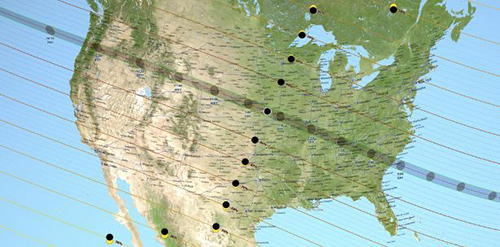
Caption: A map of the United States showing the path of totality for the August 21, 2017 total solar eclipse. Image credit: NASA’s Scientific Visualization Studio
On August 21st, the sky will darken, the temperature will drop and all fifty United States will be able to see the Moon pass—at least partially—in front of the Sun. It’s a solar eclipse!
A solar eclipse happens when the Moon passes between the Sun and Earth, casting its shadow on Earth. Sometimes the Moon only covers up part of the Sun. That is called a partial solar eclipse. When the Moon covers up the Sun completely, it’s called a total solar eclipse. As our planet rotates, the Moon’s shadow moves across Earth’s surface. The path of the inner part of this shadow, where the Moon totally covers the Sun, is called the path of totality.
The path of totality on August 21 stretches from Oregon to South Carolina. If you happen to be in that path, you will be able to experience a total solar eclipse! If you’re in any of the 50 United States during this time, you can see a partial solar eclipse.
No matter where you’ll be for the eclipse, remember that SAFETY is very important. Never look at the Sun when any part of it is exposed, like during a partial eclipse! It can hurt your eyes very badly. If you want to view the eclipse, you can buy special eclipse glasses. Go the NASA 2017 Eclipse Safety website to learn more about what glasses to buy.
If you are in the path of the total eclipse, you may look directly at the eclipse only when the Moon has completely covered the Sun. This is called totality, and it lasts a very short time. You must be sure to put your eclipse glasses back on before the Sun peeks out from behind the Moon.
You won’t be the only one watching this event! NASA scientists will use this eclipse to study our Sun. During a total solar eclipse, we can see the Sun’s atmosphere, called the corona. Usually the Sun is so bright that we can’t see the corona. However, when the Moon blocks out most of the Sun’s light, we can get a glimpse of the corona.
The surface of the Sun is about 10,000 degrees Fahrenheit, but the corona is much hotter. It’s about 2 million degrees Fahrenheit! The eclipse gives NASA researchers the chance to learn more about why the corona is so hot. In fact, while the eclipse will only last about two to three minutes in one place, scientists have found a way to have more time to study it.
NASA will use two research jets to chase the eclipse as it crosses the country. The jets will fly very high, and spend seven minutes in the shadow of the Moon. Researchers are using jets to help look for small explosions on the Sun, called nanoflares. These nanoflares may help to explain the corona’s extreme heat.
Whether you’re watching with eclipse glasses from the ground, or in a NASA jet from the sky, the 2017 eclipse should be quite a show! It’s a fun reminder of our place in the solar system, and how much we still have to learn.
To learn more about solar eclipses, check out this NASA Space Place video:https://spaceplace.nasa.gov/eclipse-snap


